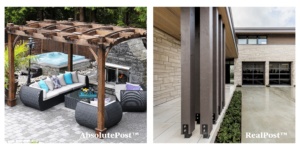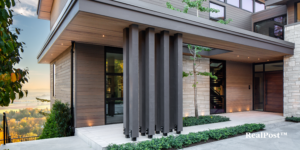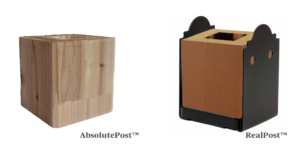To learn more about our AbsoluteCedar™ product line and get a free sample, click here.
Pergolas, gazebos, decks, interiors, exteriors, structures, decorations – the possibilities offered by wood post products are countless. However, a paradigm shift has been brought on by structurally certified post products, completely transforming the level of trust that Builders and Architects invest in their projects.
This shift started for Woodtone 25 years ago when we identified a crucial need within the building and architecture communities for Certified Engineered Wood Post that seamlessly blend reliability, performance and aesthetics. While these products may outwardly resemble ordinary posts, they have undergone rigorous testing to earn their seal of structural certification. From this, we innovated two of our most integrally designed products: AbsolutePost™ and RealPost™.
Both posts proudly bear the badge of structural certification, embodying the essence of meticulous engineering and confidence in the aspect of safety. Available in hollow and solid iterations, AbsolutePost™ and RealPost™ are adaptable to an extensive range of load-bearing and decorative applications across interior and exterior spaces.
To discuss the creation of our post products, the importance of certification and the intensive testing process it takes to make high-performing certified engineered wood post products, we sat down with industry experts Hal Hanlon, President of Woodtone Specialties, and Shane Harsch, VP of Specialty Products.
Q: What is the history of our RealPost™ and AbsolutePost™?
Hal: The plant in Armstrong has been making structurally certified engineered wood post for over 25 years.
Our AbsolutePost™ and RealPost™ were designed as market and supply solutions.
This looked like creating a post resistant to splitting and being offered specified lengths. The structural certification aspect of it is to give our customers the confidence that the posts will perform.
From the supply standpoint, our ability to finger joint means we can make specified lengths, but more importantly, we take wood with up to #3 wane and utilize it to make these posts.
Q: What are the differences between AbsolutePost™ and RealPost™?
Shane: The main difference is the species, which makes the product look and perform differently.

Our AbsolutePost™ made from Western Red Cedar comes raw to be coated on-site and applied in an exterior application exposed to the weather. For example, those would include outdoor structures like pergolas that are directly exposed to weathering.
Similarly, our RealPost™ comes pre-primed and ready to ready to paint on-site. They perform best in both structural and decorative applications where the product is undercover. These applications include porches and other building applications not directly exposed to exterior elements.
Q: How do our posts differ from others on the market? (Certified Engineered Wood Post)
Shane: Compared to regular non-engineered and other engineered posts on the market, AbsolutePost™ and RealPost™ are certified for load-bearing capabilities, are roughly 50% lighter and carry a greater load capacity.
Both posts are also significantly more dimensionally stable, meaning they don’t warp, twist, or split, eliminating callbacks due to quality issues.
They also come in the specified lengths that customers want which saves them money in not having to incur unnecessary trim-loss in the field.
Q: Why choose a structurally certified post vs. a non-certified one?
Hal: One of the biggest issues for our customers is the confidence that products will perform in the field. When you’re dealing with structural products, there are potential liability issues.
“For me personally, I wouldn’t put a post on my house that wasn’t certified. I want the confidence that my deck will stay up and remain structurally integral.”
I also want to trust that the post will not split and look worn.

Because our knot size is much smaller, our posts look better than solid posts that have significantly larger allowable knots. As a result, our posts almost look like a piece of furniture.

Shane: Our posts are structurally manufactured and third-party certified by Intertek (which we will get into later).
This means homeowners, builders, developers and engineers can specify our products with ease and confidence. Liability is a huge issue, so we are glad we can virtually eliminate this risk as it pertains to structural posts.
Q: What does structurally manufactured and certified really mean?
Hal: Structurally manufactured and certified engineered wood post means the posts need to adhere to stringent standards outlined by international building codes.
We follow the ASTM code (American Society for Testing and Materials).
ASTM outlines testing requirements that we must perform on the product for certification.
Our third-party auditor, Intertek, then checks to ensure we follow the appropriate testing and sampling.
Q: Who is Intertek?
Shane: They are an internationally recognized independent total quality assurance provider.
They provide auditing of testing, inspections, training, and auditing to give us certifications for our engineered products.
Q: What are Woodtone’s internal testing standards?
Hal: It is essentially the testing we must do to meet the certification. It requires us to pull samples from our production off the floor every hour, bring them to our labs and put them through multiple stringent tests.

Our testing includes finger joint strength testing, which means we pull our finger joints to break. We then perform cyclic delamination testing, which is accelerated weathering. We inject moisture into the product and oven-baking it repetitively to simulate what 25 years of weathering would look like. Lastly, we do a bend test, which is Modulus of Elasticity (MOE) testing, in combination with compression tests, which is vertical load testing.
We track each batch of products to identify any problems before they leave our plant and go into the field.
Q: What is the importance of Woodtone investing in internal testing standards? And what is the importance of it for customers?
Shane: It allows us to provide the pinnacle standard in product quality for 100% of our engineered products.
“This gives our customers maximum confidence in using our products to carry structural loads and have a beautiful appearance. “
Thank you again to Hal and Shane for their time and for sharing invaluable insight on our certified engineered wood post products.
Are you interested in learning more about our certified engineered wood post products? You can check out our AbsolutePost™ HERE and RealPost™ HERE.
Watch Shane and Hals gull interview, here:
Learn more about our engineered AbsoluteCedar™ product line or get a free sample:
